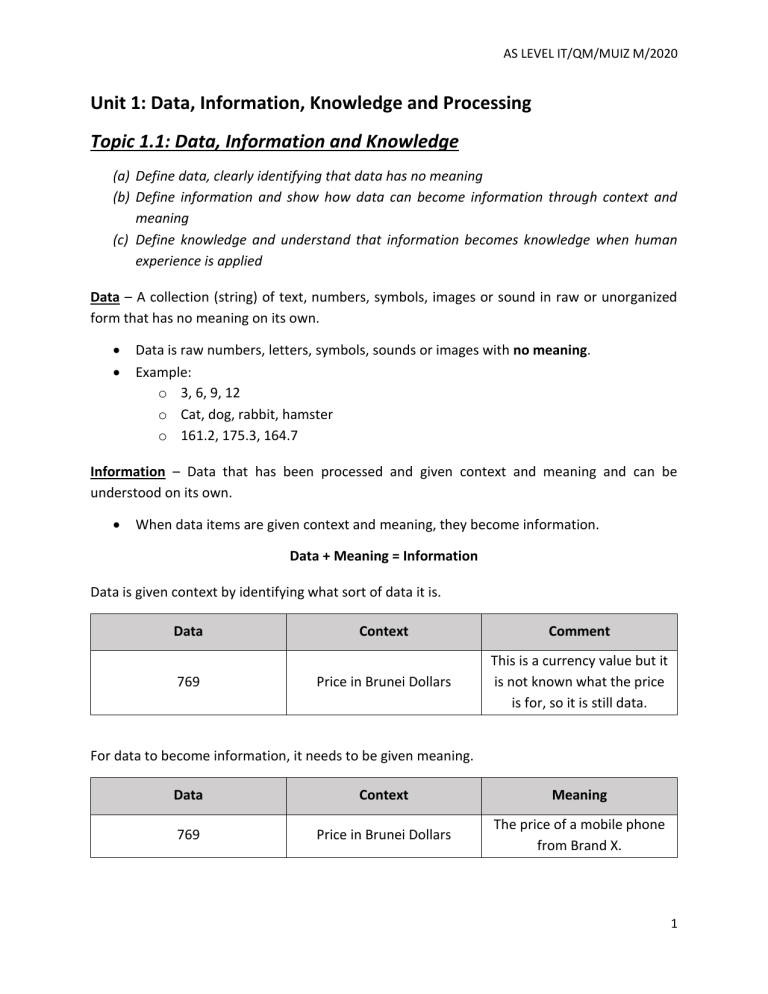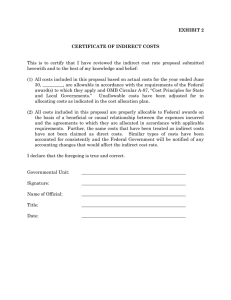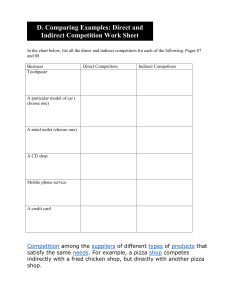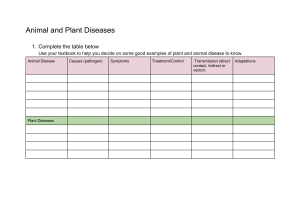IT_Chapter 1 (Part 1) - Data, Information, Knowledge and Processing
advertisement

AS LEVEL IT/QM/MUIZ M/2020 Unit 1: Data, Information, Knowledge and Processing Topic 1.1: Data, Information and Knowledge (a) Define data, clearly identifying that data has no meaning (b) Define information and show how data can become information through context and meaning (c) Define knowledge and understand that information becomes knowledge when human experience is applied Data – A collection (string) of text, numbers, symbols, images or sound in raw or unorganized form that has no meaning on its own. Data is raw numbers, letters, symbols, sounds or images with no meaning. Example: o 3, 6, 9, 12 o Cat, dog, rabbit, hamster o 161.2, 175.3, 164.7 Information – Data that has been processed and given context and meaning and can be understood on its own. When data items are given context and meaning, they become information. Data + Meaning = Information Data is given context by identifying what sort of data it is. Data 769 Context Comment Price in Brunei Dollars This is a currency value but it is not known what the price is for, so it is still data. For data to become information, it needs to be given meaning. Data Context Meaning 769 Price in Brunei Dollars The price of a mobile phone from Brand X. 1 AS LEVEL IT/QM/MUIZ M/2020 Example: Knowledge – the acquisition by a person or medium of information in which human experience has been applied and requires understanding such as how to solve problems Knowledge is what a person knows. This is known as their knowledge base. A knowledge base gets larger over time as a person gains experience or learning. Knowledge base – the amount of information a person or medium knows that often expands over time with the addition of new information. Information Knowledge 769 Brunei Dollars is the price of a mobile phone from Brand X. The price of the mobile phone is more cheaper than the latest tablet from Brand Y. In computing terms, knowledge is also what a machine knows through the use of knowledge base consisting of rules and facts, often found in knowledge-based systems, modelling and simulation software. Topic 1.2: Sources of Data (a) (b) (c) (d) (e) Define static data and give an example Define dynamic data and give an example Compare the use of static information sources with dynamic information sources Define direct and indirect data source Understand the advantages and disadvantages of gathering data from direct and indirect data sources There are two types of data: static data and dynamic data. There are different methods used to obtain data: direct data source and indirect data source. Static data – Data that does not normally change and remains constant. Static means ‘still’. The data does not normally change during processing. Static data either is fixed or has to be changed manually by editing a document. 2 AS LEVEL IT/QM/MUIZ M/2020 Example: A newspaper story – hardcopy cannot be changed once printed. Data stored on a CD ROM – a CD ROM cannot be edited. Dynamic data – Data that change automatically without user intervention. Dynamic means ‘moving’. The data that changes during processing. The data is updated as and when necessary because of the source data is changing. Example: News feed on a mobile phone application. Data on a webpage that is providing real-time information. Static information sources compared with dynamic information sources Static Information Source Dynamic Information Source The information does not change on a regular basis. The information can go out of date quickly because it is not designed to be changed on a regular basis. Information is updated automatically when the original data changes. It is most likely to be up to date as it changes automatically based on the source data. The information can be viewed offline because live data is not required. An internet or network connection to the source data is required, which can be costly and can also be slow in remote areas. It is more likely to be accurate because time will have been taken to check the information being published, as it will be available for a long period of time. The data may have been produced very quickly and so may contain errors. Direct data source – Data that is collected first-hand for the purpose for which it will be used. Data collected from a direct data source or primary source must be used for the same purpose for which it was collected. Example: A music shop wants to find out what other shops are charging for music trainers. This data can be collected from various direct sources: Visiting the other shops and noting down the prices. Carrying out survey of other shop owners to ask their prices. 3 AS LEVEL IT/QM/MUIZ M/2020 Indirect data source – Data that was collected for a different purpose (secondary source). Data collected from an indirect data source or secondary source already existed for another purpose. Example: The music shop could use various indirect sources to find out what other shops are charging for trainers including: Looking at till receipts from the shop Carrying out survey of customers who have purchased trainers from the other shops Advantages and disadvantages of gathering data from direct and indirect data sources Direct Data Source Indirect Data Source The data will be relevant because what is needed has been collected. Additional data that is not required will exist that may take time to sort through and some data that is required may not exsit. The original source is known and so can be trusted. The original source may not be known and so it cannot be assumed that it is reliable. It can take a long time to gather original data rather than use data that already exists. The data is immediately available. A large sample of statistical data can be difficult to collect for one-off purposes. If statistical analysis is required, then there are more likely to be large samples available. The data is likely to be up to date because it has been collected recently. Data may be out of date because it was collected at different time. Bias can be eliminated by asking specific questions. Original data may be biased due to its source. The data can be collected and presented in the format required. The data is unlikely to be in the format required, which may make extracting the data difficult 4 AS LEVEL IT/QM/MUIZ M/2020 Topic 1.3: Quality of Information (a) Understand how accuracy, relevance, age, level of detail and completeness of the information can affect its quality Quality of information is the fitness of the information for the purpose. The information is of good quality if it fits for the purpose and good enough for the intended job. Accuracy – Data must be accurate. The accuracy of information relies on the underlying data. The collected data must be accurate; otherwise, the produced information will be inaccurate. Examples of inaccurate information include: Misspelling of word where there can have completely different meanings: “peace” and “piece” Decimal point in the wrong place: $10.30 and $103.00 Misplaced characters: such as a licence plate of BAA 1243 instead of BAA 1234 Relevance – Information must be relevant to its purpose. In order for information to be useful, data must be relevant. Relevant information is the information that meets the need of the user: information that can help towards finding a solution to the problem or task. Examples of irrelevant information include: A program requesting the age of the user but the date of birth is typed instead. A user guide on how to install a software on a computer which includes instructions on how to assemble a plug. Age – Information must be up to date. In order for the information to be useful, the data needs to be up to date. Information changes over time, so old, out-of-date information can be misleading. Examples of out-of-date information: A digital clock that has not been updated for 5 minutes in which definitely that the time has passed. The number of users based on the year of 2010, but 400 new accounts has been created since then. 5 AS LEVEL IT/QM/MUIZ M/2020 Level of detail – Good quality information required the right amount of information. In order to be helpful in solving a problem, the information use needs to have the correct level of detail. Giving too much information will make it difficult to find what you require. Whereas, too little information will make it hard for you to understand or make sure of the information provided. Example: A person orders a pizza. They ask for a large pepperoni to be delivered. They forgot to say what type of base they wanted and where it should be delivered. The pizza company does not have enough information to fulfil the order. Completeness – All information required should be present. In order for information to be useful, it needs to be complete. If parts of information are missing then you will not be able to make use of it or make accurate decisions. Example: A person has booked their car in for a service over the phone. The mechanic tells them the name of the street but does not give building number. 6






